51 results
Common Core L.11-12.6 homeschool curricula
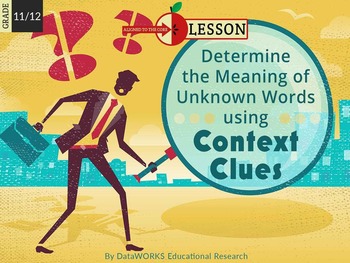
Determine the Meaning of Unknown Words Using Context Clues
This Common Core language lesson asks students to determine the meaning of unknown words using context clues. In the lesson, students will identify context clues in a passage (not just a sentence) that suggest the meaning of a bolded word. Then, they will identify the meaning of the bolded word and use it in a sentence. In addition to the lesson, there are numerous pages of Independent Practice and review with questions modeled after the Common Core assessment items.
Check out more of our less
Grades:
9th - 12th
Types:
CCSS:
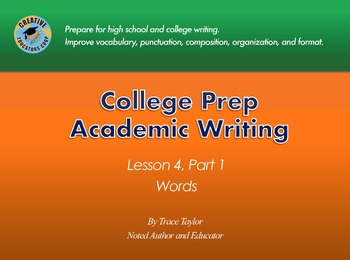
Academic Writing Lesson 4 Part 1: Words
One of 30+ lesson plans that make up a middle school advanced placement and high school writing curriculum that prepares and leverages students for collegiate level writing. Note that this 1-30 academic writing curriculum will cover all of the writing standards from 5th to 12th grades as a whole, not individually. The whole is engineered to cover all aspects of writing and relative language mastery expected at the college level.This lesson is the first part of a deep dive into into words and the
Subjects:
Grades:
6th - 12th, Higher Education, Adult Education
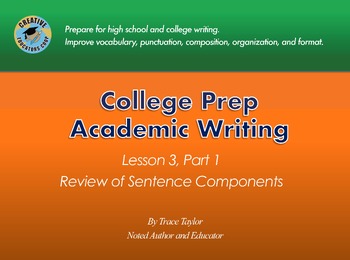
Academic Writing Lesson 3 Part 1: Review of Sentence Components
One of 30+ lesson plans that make up a middle school advanced placement and high school writing curriculum that prepares and leverages students for collegiate level writing. Note that this 1-30 academic writing curriculum will cover all of the writing standards from 5th to 12th grades as a whole, not individually. The whole is engineered to cover all aspects of writing and relative language mastery expected at the college level.This lesson reviews foundational language and writing knowledge. Not
Subjects:
Grades:
6th - 12th, Higher Education, Adult Education
Types:
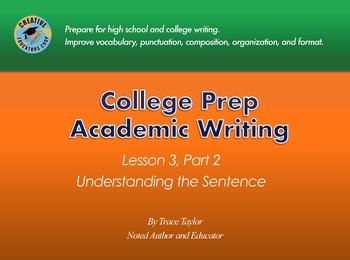
Academic Writing Lesson 3 Part 2: Understanding the Sentence
One of 30+ lesson plans that make up a middle school advanced placement and high school writing curriculum that prepares and leverages students for collegiate level writing. Note that this 1-30 academic writing curriculum will cover all of the writing standards from 5th to 12th grades as a whole, not individually. The whole is engineered to cover all aspects of writing and relative language mastery expected at the college level.This lesson is a deep dive into the constructions and components of
Subjects:
Grades:
6th - 12th, Higher Education, Adult Education
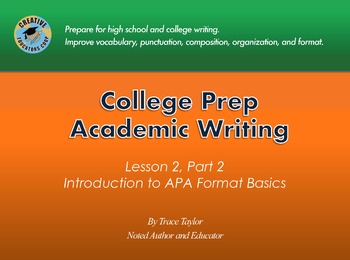
Academic Writing Lesson 2 Part 2: Introduction Format Basics
One of 30+ lesson plans that make up a middle school advanced placement and high school writing curriculum that prepares and leverages students for collegiate level writing. Note that this 1-30 academic writing curriculum will cover all of the writing standards from 5th to 12th grades as a whole, not individually. The whole is engineered to cover all aspects of writing and relative language mastery expected at the college level.This lesson continues the introduction to APA formatting for academi
Subjects:
Grades:
6th - 12th, Higher Education, Adult Education
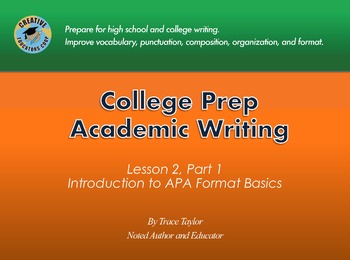
Academic Writing Lesson 2 Part 1: Introduction to APA Format Basics
One of 30+ lesson plans that make up a middle school advanced placement and high school writing curriculum that prepares and leverages students for collegiate level writing. Note that this 1-30 academic writing curriculum will cover all of the writing standards from 5th to 12th grades as a whole, not individually. The whole is engineered to cover all aspects of writing and relative language mastery expected at the college level.This 2nd lesson in 2 parts instructs on the APA formatting required
Subjects:
Grades:
6th - 12th, Higher Education, Adult Education
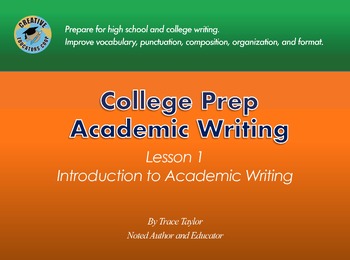
Academic Writing Lesson 1: Intro to Academic Writing
One of 30+ lesson plans that make up a middle school advanced placement and high school writing curriculum that prepares and leverages students for collegiate level writing. Note that this 1-30 academic writing curriculum will cover all of the writing standards from 5th to 12th grades as a whole, not individually. The whole is engineered to cover all aspects of writing and relative language mastery expected at the college level.This 1st lesson gives an overview of what academic writing is and wh
Subjects:
Grades:
6th - 12th, Higher Education, Adult Education

Journalism 101 Class
A fully comprehensive introduction to Journalism curriculum/course/lesson plan. Suitable for high school students to freshman/sophomore college students. Full semester of teacher/learning materials (12 weeks of instruction material). Covers the following material: Foundational Principals of Journalism; Basics of All Journalism; Types of Stories/Sections Within the Paper (features, editorials, sports, etc.); Media Law; Media Ethics; Community Journalism; Radio Journalism; Online Journalism; Photo
Subjects:
Grades:
7th - 12th, Higher Education
CCSS:
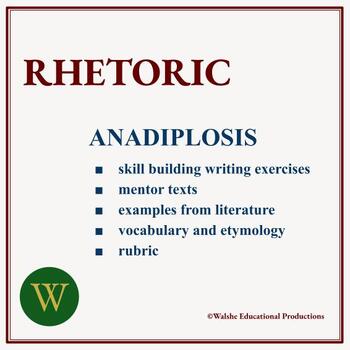
Rhetoric Lesson Seven: Anadiplosis
Rhetoric lessons are a great way of introducing students to figures of speech and how to use them. This no-prep lesson in anadiplosis is the seventh in my series of thirty rhetoric lessons. Simple, easy to follow definitions and examples are included, along with practice exercises and a rubric. I use these lessons with students from grades 7 to 12. They enjoy the simple challenge of writing according to the form of each rhetorical device. Students from a variety of skill levels, including Englis
Subjects:
Grades:
7th - 12th, Adult Education
CCSS:
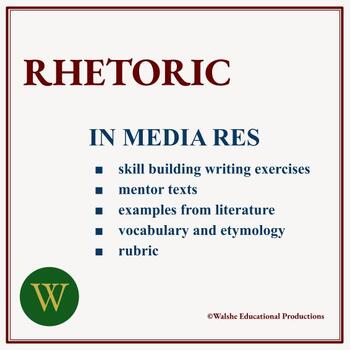
Rhetoric Lesson Twenty-five: In Media Res
Rhetoric lessons are a great way of introducing students to figures of speech and how to use them. This no-prep lesson in In Media Res is the twenty-fifth in my series of thirty rhetoric lessons. Simple, easy to follow instructions and examples are included, along with practice exercises and a rubric. I use these lessons with students from grades 7 to 12. They enjoy the simple challenge of writing according to the form of each rhetorical device. Students from a variety of skill levels, including
Subjects:
Grades:
7th - 12th, Adult Education
CCSS:
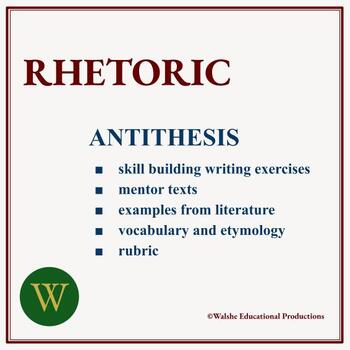
Rhetoric Lesson Twenty-six: Antithesis
Rhetoric lessons are a great way of introducing students to figures of speech and how to use them. This no-prep lesson in antithesis is the twenty-sixth in my series of thirty rhetoric lessons. Simple, easy to follow instructions and examples are included, along with practice exercises and a rubric. I use these lessons with students from grades 7 to 12. They enjoy the simple challenge of writing according to the form of each rhetorical device. Students from a variety of skill levels, including E
Subjects:
Grades:
7th - 12th, Adult Education
CCSS:
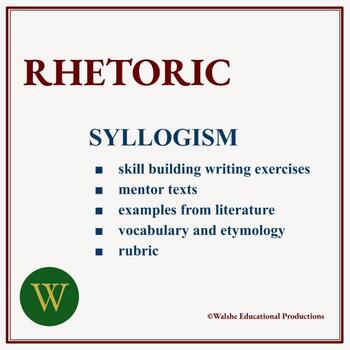
Rhetoric Lesson Twenty-one: Syllogism
Rhetoric lessons are a great way of introducing students to figures of speech and how to use them. This no-prep lesson in syllogism is the twenty-first in my series of thirty rhetoric lessons. Simple, easy to follow instructions and examples are included, along with practice exercises and a rubric. I use these lessons with students from grades 7 to 12. They enjoy the simple challenge of writing according to the form of each rhetorical device. Students from a variety of skill levels, including En
Subjects:
Grades:
7th - 12th, Adult Education
CCSS:
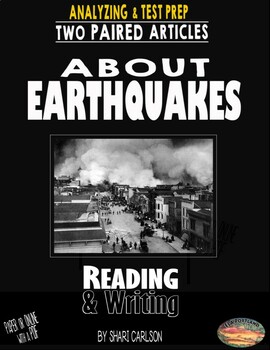
Articles - 2: PAIRED - ABOUT EARTHQUAKES - Nonfiction Narrative: EARTHQUAKE!
READING & WRITING ANALYZING - COMPREHENSION - TEST PREP.....................................................2 PAIRED TEXTS TEXT #1 “EARTHQUAKE!” is a NONFICTION NARRATIVE describing the author's experience being in an earthquake.TEXT #2“ABOUT EARTHQUAKES” is a NONFICTION ARTICLE explaining how earthquakes work.TOPICS APPROPRIATE for students in 4th – 12th grades........................................................INCLUDESTWO TEXTS - PDF MULTIPLE CHOICE questions & KEYWRITING PROMPTSam
Subjects:
Grades:
4th - 12th
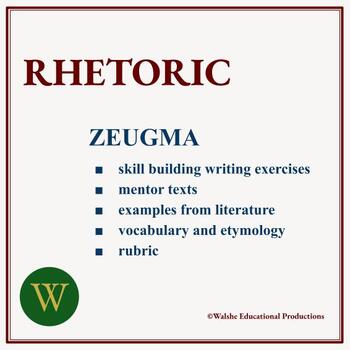
Rhetoric Lesson Twenty-seven: Zeugma
Rhetoric lessons are a great way of introducing students to figures of speech and how to use them. This no-prep lesson in antithesis is the twenty-seventh in my series of thirty rhetoric lessons. Simple, easy to follow instructions and examples are included, along with practice exercises and a rubric. I use these lessons with students from grades 7 to 12. They enjoy the simple challenge of writing according to the form of each rhetorical device. Students from a variety of skill levels, including
Subjects:
Grades:
7th - 12th, Adult Education
CCSS:
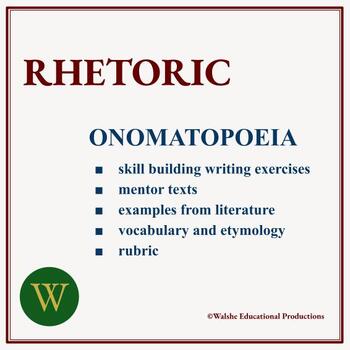
Rhetoric Lesson Twenty-four: Onomatopoeia
Rhetoric lessons are a great way of introducing students to figures of speech and how to use them. This no-prep lesson in onomatopoeia is the twenty-fourth in my series of thirty rhetoric lessons. Simple, easy to follow instructions and examples are included, along with practice exercises and a rubric. I use these lessons with students from grades 7 to 12. They enjoy the simple challenge of writing according to the form of each rhetorical device. Students from a variety of skill levels, includin
Subjects:
Grades:
7th - 12th, Adult Education
CCSS:

Rhetoric Lesson Twenty-two: Tautology
Rhetoric lessons are a great way of introducing students to figures of speech and how to use them. This no-prep lesson in tautology is the twenty-second in my series of thirty rhetoric lessons. Simple, easy to follow instructions and examples are included, along with practice exercises and a rubric. I use these lessons with students from grades 7 to 12. They enjoy the simple challenge of writing according to the form of each rhetorical device. Students from a variety of skill levels, including E
Subjects:
Grades:
7th - 12th, Adult Education
CCSS:
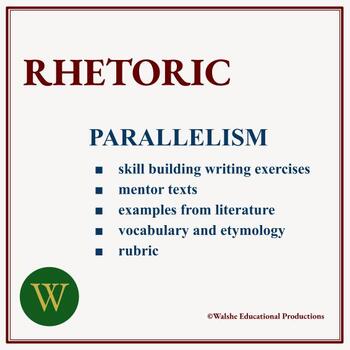
Rhetoric Lesson Twenty: Parallelism
Rhetoric lessons are a great way of introducing students to figures of speech and how to use them. This no-prep lesson in parallelism is the twentieth in my series of thirty rhetoric lessons. Simple, easy to follow instructions and examples are included, along with practice exercises and a rubric. I use these lessons with students from grades 7 to 12. They enjoy the simple challenge of writing according to the form of each rhetorical device. Students from a variety of skill levels, including Eng
Subjects:
Grades:
7th - 12th, Adult Education
CCSS:

Rhetoric Lesson Twenty-nine: Simile
Rhetoric lessons are a great way of introducing students to figures of speech and how to use them. This no-prep lesson in simile is the twenty-ninth in my series of thirty rhetoric lessons. Simple, easy to follow instructions and examples are included, along with practice exercises and a rubric. I use these lessons with students from grades 7 to 12. They enjoy the simple challenge of writing according to the form of each rhetorical device. Students from a variety of skill levels, including Engli
Subjects:
Grades:
7th - 12th, Adult Education
CCSS:
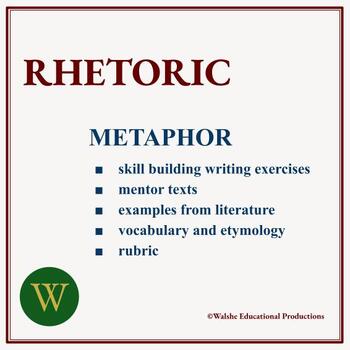
Rhetoric Lesson Twenty-eight: Metaphor
Rhetoric lessons are a great way of introducing students to figures of speech and how to use them. This no-prep lesson in metaphor is the twenty-eighth in my series of thirty rhetoric lessons. Simple, easy to follow instructions and examples are included, along with practice exercises and a rubric. I use these lessons with students from grades 7 to 12. They enjoy the simple challenge of writing according to the form of each rhetorical device. Students from a variety of skill levels, including En
Subjects:
Grades:
7th - 12th, Adult Education
CCSS:
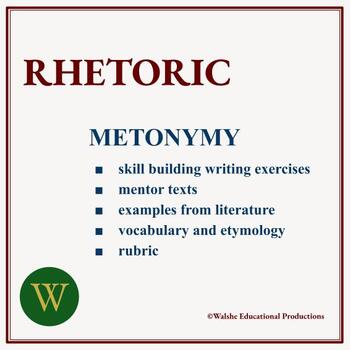
Rhetoric Lesson Thirty: Metonymy
Rhetoric lessons are a great way of introducing students to figures of speech and how to use them. This no-prep lesson in metonymy is the thirtieth in my series of thirty rhetoric lessons. Simple, easy to follow instructions and examples are included, along with practice exercises and a rubric. I use these lessons with students from grades 7 to 12. They enjoy the simple challenge of writing according to the form of each rhetorical device. Students from a variety of skill levels, including Englis
Subjects:
Grades:
7th - 12th, Adult Education
CCSS:

Rhetoric Lesson Thirteen: Oxymoron
Rhetoric lessons are a great way of introducing students to figures of speech and how to use them. This no-prep lesson in oxymoron is the thirteenth in my series of thirty rhetoric lessons. Simple, easy to follow instructions and examples are included, along with practice exercises and a rubric. I use these lessons with students from grades 7 to 12. They enjoy the simple challenge of writing according to the form of each rhetorical device. Students from a variety of skill levels, including Engli
Subjects:
Grades:
7th - 12th, Adult Education
CCSS:
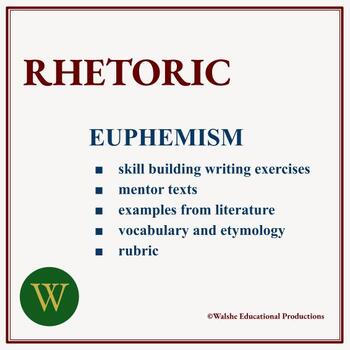
Rhetoric Lesson Twenty-three: Euphemism
Rhetoric lessons are a great way of introducing students to figures of speech and how to use them. This no-prep lesson in euphemism is the twenty-third in my series of thirty rhetoric lessons. Simple, easy to follow instructions and examples are included, along with practice exercises and a rubric. I use these lessons with students from grades 7 to 12. They enjoy the simple challenge of writing according to the form of each rhetorical device. Students from a variety of skill levels, including En
Subjects:
Grades:
7th - 12th, Adult Education
CCSS:

Rhetoric Lesson Nineteen: Consonance
Rhetoric lessons are a great way of introducing students to figures of speech and how to use them. This no-prep lesson in consonance is the nineteenth in my series of thirty rhetoric lessons. Simple, easy to follow instructions and examples are included, along with practice exercises and a rubric. I use these lessons with students from grades 7 to 12. They enjoy the simple challenge of writing according to the form of each rhetorical device. Students from a variety of skill levels, including Eng
Subjects:
Grades:
7th - 12th, Adult Education
CCSS:

Rhetoric Lesson Eighteen: Assonance
Rhetoric lessons are a great way of introducing students to figures of speech and how to use them. This no-prep lesson in assonance is the eighteenth in my series of thirty rhetoric lessons. Simple, easy to follow instructions and examples are included, along with practice exercises and a rubric. I use these lessons with students from grades 7 to 12. They enjoy the simple challenge of writing according to the form of each rhetorical device. Students from a variety of skill levels, including Engl
Subjects:
Grades:
7th - 12th, Adult Education
CCSS:
Showing 1-24 of 51 results

